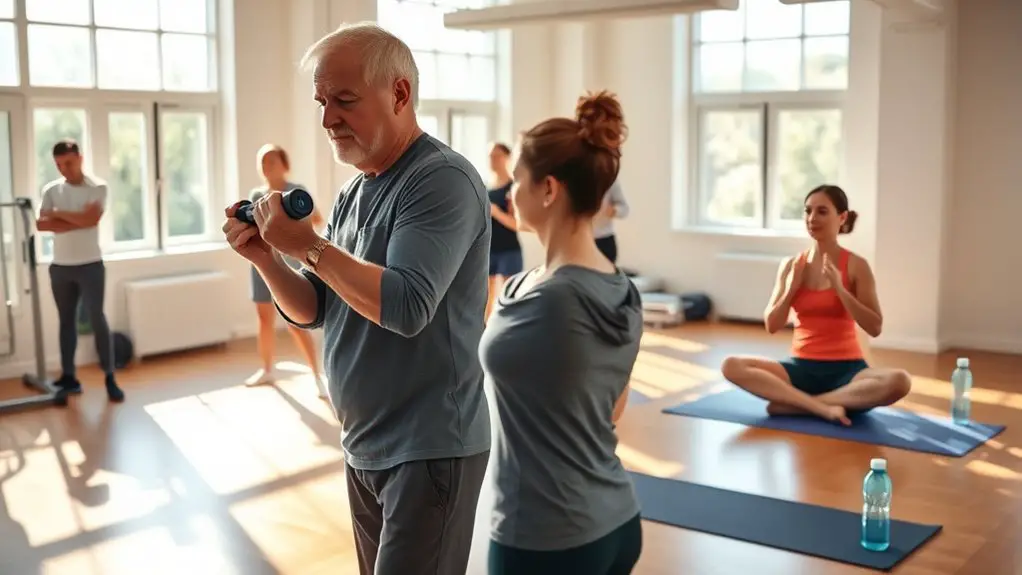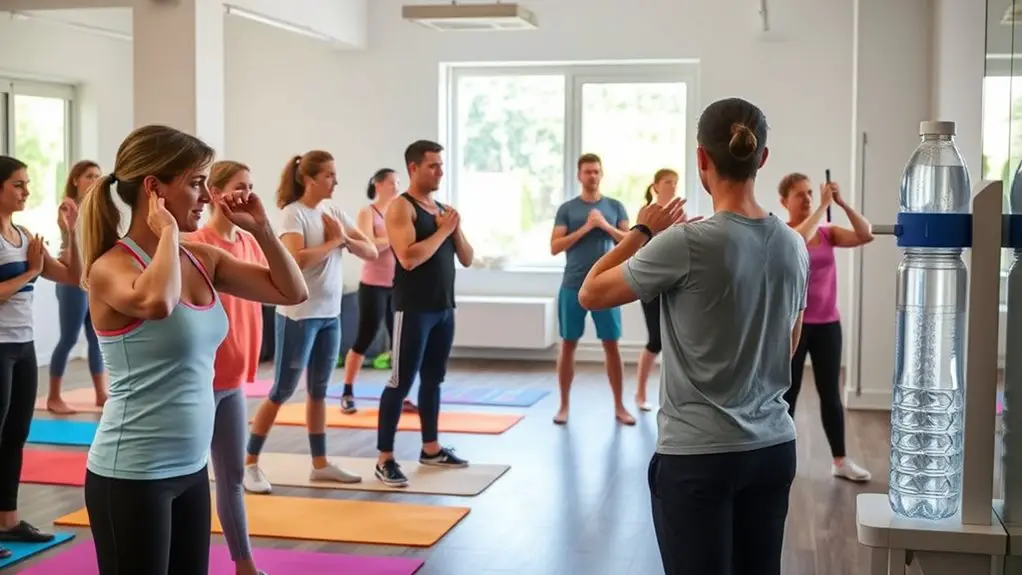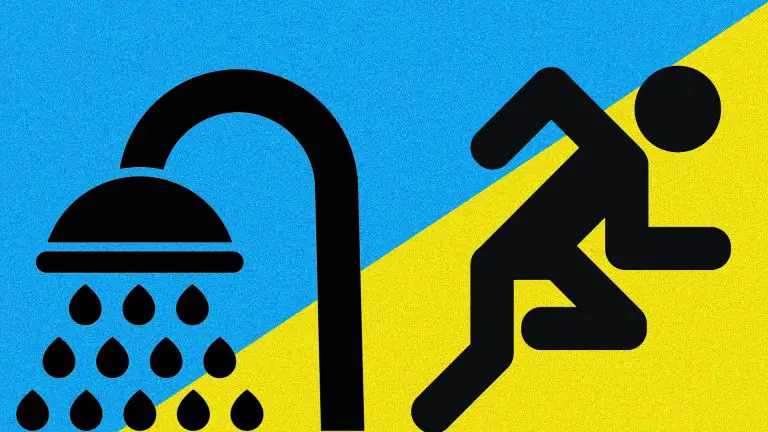Gym Training for People With High Blood Pressure

If you have high blood pressure, gym training is vital for managing your health. Regular exercise lowers blood pressure and improves heart health. Focus on low-impact cardio, like walking or cycling, and incorporate strength training to build muscle. Remember to warm up and cool down properly, and monitor your blood pressure during workouts. It’s important to consult a healthcare provider for personalized guidance. There’s more to take into account in creating a balanced and effective fitness routine.
Understanding High Blood Pressure and Its Risks

High blood pressure, often called hypertension, is a silent condition that can lead to serious health risks if left unmanaged. Understanding the causes of hypertension is essential for your safety. Factors like poor diet, lack of physical activity, and stress can contribute to high blood pressure. Being aware of these triggers can help you make healthier choices.
Symptoms of hypertension aren’t always obvious, which is why symptoms awareness is important. You might experience headaches, dizziness, or blurred vision, but often, there are no noticeable signs at all. Regular check-ups with your healthcare provider can help monitor your blood pressure and identify any concerns early on.
The Benefits of Exercise for Hypertension
Managing hypertension effectively often involves lifestyle changes, and exercise is one of the most beneficial steps you can take. Regular physical activity helps lower your blood pressure and can greatly improve your overall heart health. You’ll find that even moderate exercise, like walking or cycling, brings exercise benefits that enhance your well-being.
Engaging in consistent workouts can strengthen your heart, making it more efficient at pumping blood, which reduces the strain on your arteries. This is vital for effective hypertension management. Exercise also helps you maintain a healthy weight, which is another key factor in controlling blood pressure.
Moreover, physical activity can reduce stress and anxiety levels, contributing to better blood pressure control. By incorporating exercise into your routine, you’re not just addressing hypertension; you’re investing in a healthier and more vibrant life. Remember, always consult with your healthcare provider before starting any new exercise program to verify it’s safe for you. Additionally, skipping rope can be a fun and effective way to improve cardiovascular fitness while managing blood pressure.
Safe Exercise Guidelines for Individuals With High Blood Pressure

When it comes to exercising with high blood pressure, it’s vital to follow some safety guidelines to guarantee your routine is both effective and safe. Start by consulting your healthcare provider before beginning any new exercise program. They can offer personalized advice and help determine your exercise limits.
Incorporate exercise modifications to suit your individual needs. Low-impact activities, like walking or swimming, are often preferable. Be sure to warm up and cool down properly to prevent sudden spikes in blood pressure.
Activity tracking is also key; keeping a log of your workouts can help you monitor your progress and identify any patterns that may need adjustment. Listen to your body—if you feel dizzy or overly fatigued, it’s important to stop and rest. By adhering to these guidelines, you’ll create a safer environment for your fitness journey.
Types of Workouts: Cardio vs. Strength Training
While both cardio and strength training offer unique benefits, understanding how each impacts high blood pressure can help you make informed choices about your workout routine. Cardio benefits, like improving heart health and enhancing circulation, can help lower blood pressure levels. Activities such as brisk walking or cycling can be great options, as they’re generally low-impact and easy to adjust to your fitness level.
On the other hand, strength advantages can’t be overlooked. Lifting weights or using resistance bands helps build muscle, which can contribute to better overall metabolism and weight management. This is essential since maintaining a healthy weight can positively influence blood pressure.
When designing your workout plan, consider incorporating both types of exercises. Balance is key, as it allows you to enjoy the heart-healthy benefits of cardio while also reaping the muscle-building rewards of strength training. Always consult your doctor before starting any new exercise program.
Recommended Cardio Exercises for Heart Health

When it comes to cardio exercises for heart health, low-impact activities are often your best bet. You’ll want to focus on both the duration and intensity of your workouts to keep your blood pressure in check. Let’s explore some effective options that can fit into your routine.
Low-Impact Activities
Although high blood pressure can be a concern, incorporating low-impact activities into your routine can greatly benefit your heart health. Activities like yoga practices can enhance flexibility and reduce stress, which is essential for managing blood pressure. Gentle movements and focused breathing promote relaxation and mindfulness, making it a safe option for you.
Swimming routines are another excellent choice, as they provide cardiovascular benefits without putting stress on your joints. The buoyancy of water helps you move freely, allowing for a full-body workout that’s easy on the body. By engaging in these low-impact activities, you can improve your heart health while minimizing risks, ensuring you stay active and safe.
Duration and Intensity
In order to effectively manage high blood pressure, it is vital to take into account both the duration and intensity of your cardio workouts. Aim for at least 150 minutes of moderate exercise duration each week, with a focus on gradual progression. Start with low intensity levels, allowing your heart rate to rise safely. Consider a workout frequency of 3 to 5 times a week, incorporating endurance training to build stamina. It’s essential to personalize your plans based on how your body responds, ensuring you include adequate recovery times. Listen to your body, and adjust as needed. Prioritizing these factors can help you achieve better heart health while keeping safety at the forefront of your exercise journey.
Strength Training Techniques for Hypertensive Individuals
When you’re managing high blood pressure, strength training can be a valuable tool, but it’s essential to approach it wisely. Starting with a proper warm-up, following resistance training guidelines, and monitoring your blood pressure throughout your workout can make all the difference. Let’s explore how to effectively incorporate these techniques into your routine.
Importance of Warm-Up
Warm-up exercises are essential for anyone, but they’re particularly important for individuals with high blood pressure. Engaging in a proper warm-up helps prepare your body for the physical demands ahead, reducing the risk of injury. Start with dynamic stretches, like arm circles or leg swings, to increase blood flow and flexibility. These movements gently elevate your heart rate, making the shift to more intense workouts smoother. Incorporating flexibility exercises, such as gentle torso twists or calf stretches, can further enhance your performance while promoting joint health. Remember, a well-structured warm-up isn’t just a routine; it’s a key step for ensuring your safety and comfort as you begin your strength training journey. Always listen to your body and adjust as needed.
Resistance Training Guidelines
While resistance training can be highly beneficial for those with high blood pressure, it’s vital to follow specific guidelines to guarantee safety and effectiveness. Start by choosing low to moderate-intensity resistance exercises, focusing on larger muscle groups. Aim for a training frequency of two to three times a week, allowing for adequate rest between sessions. It’s important to maintain proper form to prevent injury and avoid holding your breath during lifts, as this can spike your blood pressure. Incorporate a mix of free weights and resistance bands, if comfortable, and keep your repetitions between 10 to 15 for each exercise. Always consult with your healthcare provider before starting any new exercise program to verify it’s right for you.
Monitoring Blood Pressure
Monitoring your blood pressure regularly is a key component of safe strength training for individuals with hypertension. Consistent blood pressure tracking helps you understand how your body responds to exercise and guarantees you stay within a safe range. Wearable devices, like smartwatches and fitness trackers, can make this process easier and more convenient.
Here’s a quick reference table to guide you:
| Monitoring Method | Benefits |
|---|---|
| Manual Cuff | Accurate readings |
| Smartwatch | Real-time tracking |
| Fitness Tracker | Activity integration |
| Smartphone App | Data analysis and trends |
Incorporate these methods into your routine to stay informed and maintain your health while strength training. Always consult your doctor to verify you’re on the right track.
The Importance of Warm-Up and Cool-Down Routines
Before diving into an intense workout, it’s essential to recognize that a proper warm-up and cool-down routine can greatly benefit your overall health, especially when managing high blood pressure. Starting with dynamic stretching helps increase blood flow to your muscles and prepares your body for the demands of exercise. This can lower your risk of injury and promote safe movement.
After your workout, don’t skip the cool-down. Gradually bringing your heart rate down with gentle stretches aids in post-exercise recovery, helping your body shift back to a resting state. It’s also a moment to reflect on your workout and guarantee you feel stable and relaxed.
Monitoring Your Blood Pressure During Workouts
Keeping an eye on your blood pressure during workouts is essential, especially if you have hypertension. Regular monitoring helps you understand how your body responds to exercise and guarantees you’re staying within safe limits. Invest in reliable blood pressure devices that are easy to use, so you can check your levels before and after your sessions.
It’s vital to establish a consistent workout frequency tailored to your fitness level and medical advice. Start with moderate-intensity exercises and gradually increase the intensity while keeping an eye on your readings. If you notice any significant changes, such as a spike in your blood pressure, it’s wise to stop and reassess your routine. Always listen to your body and consult your healthcare provider to develop an exercise plan that prioritizes your safety and well-being. Remember, your health comes first, so don’t hesitate to modify your workouts as needed.
Lifestyle Changes to Complement Your Gym Routine
To really benefit from your gym routine, you need to make some lifestyle changes too. Focusing on nutrition, managing stress, and prioritizing sleep can enhance your overall health and help keep your blood pressure in check. Let’s explore how these adjustments can support your fitness journey.
Nutritional Adjustments for Health
Although exercise is essential for managing high blood pressure, the right nutritional adjustments can greatly enhance your gym routine. To guarantee you’re fueling your body effectively, consider the following tips:
- Focus on nutrient timing to optimize energy levels and recovery
- Incorporate potassium-rich foods like bananas and leafy greens
- Limit sodium intake to help control blood pressure
- Stay hydrated by following effective hydration strategies
- Choose whole grains and lean proteins for sustained energy
These adjustments can help you feel more energized during workouts and support your overall health. Remember, a balanced diet works hand-in-hand with your exercise regimen, making it vital for managing high blood pressure safely and effectively.
Stress Management Techniques
While exercise is a powerful tool for managing high blood pressure, incorporating effective stress management techniques can further enhance your overall well-being. Mindfulness practices and breathing exercises are excellent ways to reduce stress. By integrating these techniques into your daily routine, you can promote relaxation and support your heart health.
| Technique | Benefits |
|---|---|
| Mindfulness Practices | Reduces anxiety, improves focus |
| Breathing Exercises | Lowers heart rate, calms mind |
| Meditation | Enhances emotional balance |
| Yoga | Increases flexibility, reduces tension |
Try setting aside just a few minutes each day for these practices. You’ll likely find that the combination of gym training and stress management leads to better results for your blood pressure and overall well-being.
Sleep Hygiene Importance
Getting enough quality sleep is just as important as exercise when it comes to managing high blood pressure. Establishing healthy sleep patterns can help you feel more energized and support your gym routine. Here are some tips to improve your sleep hygiene:
- Stick to a consistent sleep schedule
- Create a relaxing bedtime routine
- Limit screen time before bed
- Keep your bedroom dark and cool
- Avoid caffeine and heavy meals in the evening
Seeking Professional Guidance: When to Consult a Trainer or Doctor
When you’re managing high blood pressure, knowing when to seek professional guidance can be vital for your health. If you’re unsure about starting a gym routine, consulting a personal trainer can help tailor exercises to your needs. Additionally, if you experience symptoms like chest pain or severe headaches, it’s important to seek a medical consultation immediately.
Here’s a quick guide on when to consult a trainer or doctor:
| Situation | Consult a Personal Trainer | Consult a Doctor |
|---|---|---|
| New to exercise | Yes | No |
| Uncertain about exercises | Yes | No |
| Experiencing unusual symptoms | No | Yes |
| Managing medications | Yes | Yes |
| Need ongoing support | Yes | No |
Prioritizing safety and understanding your body’s signals is key to managing high blood pressure effectively.
Frequently Asked Questions
Can I Participate in Group Fitness Classes With High Blood Pressure?
Yes, you can participate in group fitness classes with high blood pressure, but it’s essential to prioritize safety measures. Before joining, consult with your doctor to verify it’s appropriate for you. Look for classes led by certified instructors who can accommodate your needs. Be certain to monitor your intensity, stay hydrated, and listen to your body. With the right precautions in place, you can enjoy the benefits of group classes while staying safe.
How Often Should I Check My Blood Pressure While Exercising?
When it comes to exercising, remember: “A stitch in time saves nine.” You should check your blood pressure monitoring at the start of your workout and then periodically, especially if you’re trying a new exercise frequency. Listen to your body; if you feel dizzy or unwell, take a break. It’s wise to consult with your doctor about how often you should be checking to guarantee your safety while staying active.
Are There Specific Exercises to Avoid With High Blood Pressure?
When considering exercises to avoid, it’s important to steer clear of high-intensity strength training and any aerobic exercises that require sudden bursts of energy, like sprinting. These can spike your blood pressure. Instead, focus on moderate aerobic activities like walking or cycling at a steady pace. Always consult your doctor before starting any new routine, and listen to your body; if something feels off, it’s best to stop and reassess.
Can Medication Affect My Exercise Routine for High Blood Pressure?
Imagine your heart as a clock, ticking steadily. Just like a clock needs winding, your medication timing plays an essential role in your exercise routine. If you’re on medication, it can influence your exercise intensity and energy levels. You’ll want to find the right balance, ensuring safety while reaping the benefits of physical activity. Listen to your body, and consult your doctor to tailor a routine that harmonizes with your treatment plan.
What Should I Do if I Feel Dizzy During a Workout?
If you feel dizzy during a workout, it’s important to stop and assess the situation. First, focus on your hydration strategies—drink water or a sports drink to replenish fluids. Next, use breathing techniques to help calm yourself; deep, slow breaths can ease dizziness. If symptoms persist, sit down, rest, and consider seeking medical advice. Always listen to your body, and don’t push through discomfort; your safety is the priority.





